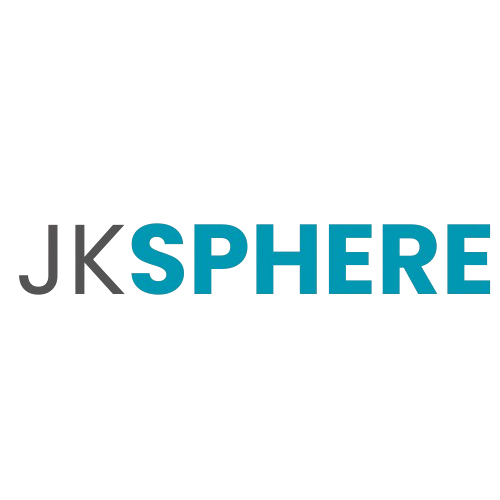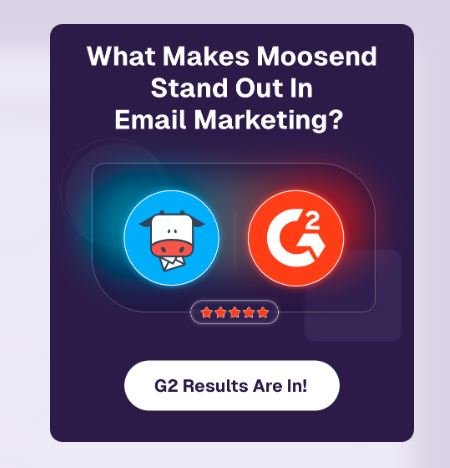
If you’re serious about growing your audience, you need more than just a signup form , W you need smart automation. GetResponse makes it easy to set up automated workflows that welcome new subscribers, send follow-up emails, and keep your audience engaged without you lifting a finger. In this guide, we’ll break down how to use GetResponse’s automation tools to build relationships, save time, and grow your email list faster than ever — even if you’re just getting started with email marketing.
What is GetResponse?

GetResponse is an all-in-one online marketing platform that helps businesses manage and automate their digital marketing activities. It’s especially popular for email marketing, but it includes many other tools too.
Our Editors review
GetResponse is one of the best email marketing tools around, especially for certain use-cases. What matters is matching features, price, usability, and scale to what you need. I’ll run through the strengths and limitations of GetResponse (compared to others), so you can decide whether it might be “the best” for you.
GetResponse Key Features
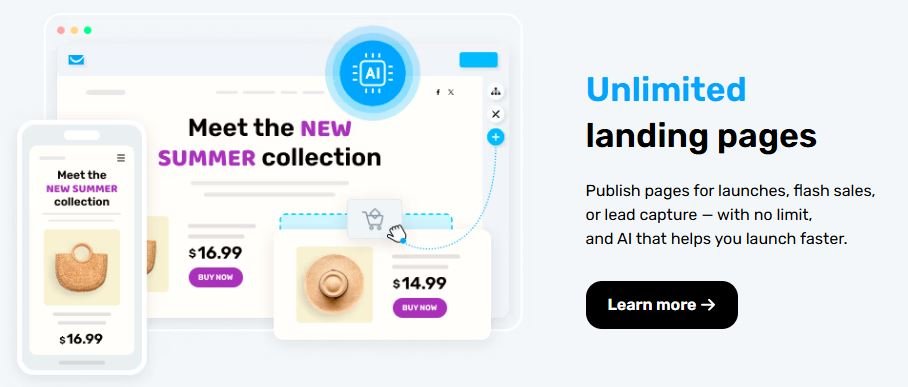
before going into how to use GetResponse automation, let first see the kay feature that Getresponse has
| Category | Feature | Description |
|---|---|---|
| Email Marketing | Email Creator | Drag-and-drop email builder with pre-made templates. |
| Autoresponders | Automatically send emails after sign-ups or specific actions. | |
| A/B Testing | Test subject lines, content, or timing to improve performance. | |
| Email Scheduling | Choose custom send times or use “Perfect Timing” AI delivery. | |
| Marketing Automation | Workflow Builder | Visual editor for behavior-based automation flows. |
| Segmentation | Group subscribers by behavior, interests, or data. | |
| Lead Scoring | Assign scores to leads based on engagement. | |
| Lead Generation | Landing Pages | Build high-converting opt-in or sales pages. |
| Conversion Funnels | Ready-made funnels for lead magnets or sales. | |
| Forms & Popups | Create sign-up forms or exit-intent popups. | |
| Webinars | Live Webinars | Host webinars with registration pages and reminders. |
| On-Demand Webinars | Offer recorded webinars for continuous lead generation. | |
| E-Commerce | Product Recommendations | Send personalized product suggestions. |
| Abandoned Cart Emails | Automatically remind users to complete purchases. | |
| Store Integrations | Works with Shopify, WooCommerce, Magento, etc. | |
| Website & Design | Website Builder | AI-powered site creator with drag-and-drop design. |
| Templates | Dozens of customizable templates for pages and emails. | |
| Analytics & Reporting | Performance Reports | Track opens, clicks, conversions, and revenue. |
| ROI Tracking | Connect campaigns to actual sales or goals. | |
| Integrations | App Connections | Integrates with WordPress, PayPal, Zapier, Facebook Ads, and more. |
| CRM & Contact Management | Built-in CRM | Manage pipelines and track customer interactions. |
| Support & Accessibility | Multi-language Support | Platform available in multiple languages. |
| 24/7 Live Chat | Round-the-clock customer support. |
How to Use GetResponse Automation to Grow Your Email List Faster
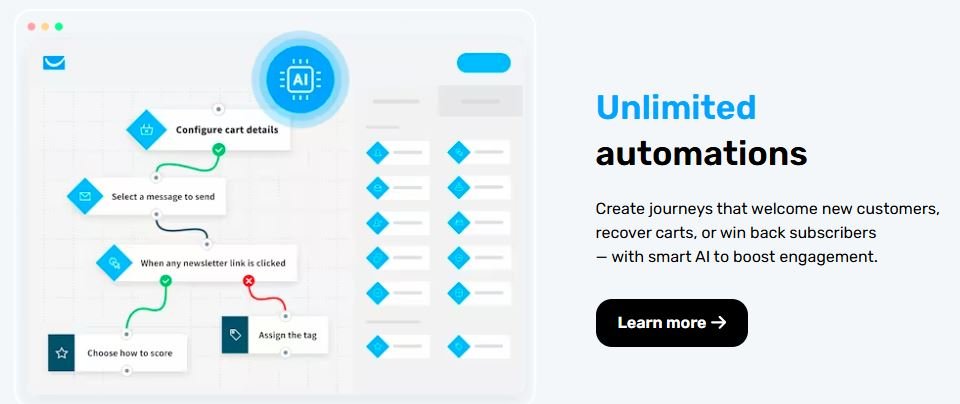
How good it is to have the system work for you automatically while you focus on something else to grow your business? Use GetResponse’s Automation tools to capture more leads, deliver instant value, and convert visitors into active subscribers faster and with less manual work.
Before you begin:
You need to have an active GetResponse account with Automation access, a verified sending domain (SPF/DKIM), one or more lead magnets ready (PDF, checklist, video link, webinar), and landing page or sign-up form copy. Prepare UTM parameters if you’ll run ads.
Step 1 Prepare account & deliverability
Verify and authenticate your sending domain to reduce spam filtering and increase deliverability.
Create the list that new signups will go into (e.g., “Leads – LeadMagnetX”).
Set up basic tags you’ll use, like “leadmagnet_downloaded,” “webinar_reg,” or “engaged.”
Step 2 Build a high-converting capture point
Create a landing page or signup form in GetResponse with a strong, benefit-focused headline and clear call to action.
Keep fields minimal (email + first name).
Add social proof and a privacy statement.
Use UTM parameters for tracking ad or post sources.
Step 3 Create the core automation workflow
Go to Automation → Create workflow.
Trigger: “Subscribes to list” (select your list).
Actions:
- Send a Welcome + Lead Magnet delivery email immediately.
- Add tag “leadmagnet_downloaded.”
- Apply a lead score if using scoring.
Wait 1 day.
If the subscriber clicked the download link, send a “Quick Tips” email.
If not, send a “Trouble downloading?” follow-up.
After 3–5 days, start a short nurture sequence that provides value and introduces your offer.
Step 4 Use double opt-in & GDPR settings
Enable double opt-in for compliance in certain regions.
If enabled, use the “Confirms subscription” trigger instead of “Subscribes to list.”
Step 5 Tagging, segmentation & lead scoring
Tag subscribers based on source and behavior, assign lead scores for engagement, and segment based on tags or scores to send targeted campaigns.
Step 6 Add behavioral triggers
If a user visits a pricing page, tag them “interested_pricing” and trigger a targeted email.
If a user clicks a product link multiple times, tag them “hot_lead” and alert sales or move them into a new sequence.
Step 7 Leverage webinars & funnels
Create a webinar signup automation: when someone registers, send confirmation, reminders, and a replay email afterward.
Use your webinar as a lead magnet funnel.
Step 8 Promote capture points
Drive paid or organic traffic to your GetResponse landing page.
Use Facebook Lead Ads or Zapier to push new leads into GetResponse.
Retarget non-converters with ads and reintroduce them into your funnel if they opt in later.
Step 9 A/B test everything
Test headlines, CTAs, form fields, and email subject lines.
Change only one variable per test.
Gather enough data before deciding which version wins.
Step 10 Measure & optimize
Track opt-in rate, open rate, click-through rate, conversion rate, list growth rate, and unsubscribe or bounce rates.
Identify which channels produce the best leads at the lowest cost.
Step 11 Automation recipes
Quick Lead Magnet Funnel: Trigger on list subscription, send Welcome + Download email, follow up after one day, and move to nurture sequence.
Webinar Funnel: Trigger on webinar registration, send confirmation and reminders, follow up with replay and CTA.
Cart Abandonment Funnel: Trigger on uncompleted purchase, send reminder after 1 hour, then offer discount after 24 hours.
Step 12 Best practices
Deliver promised value immediately in the first email.
Use curiosity and clarity in subject lines.
Personalize messages with the subscriber’s name.
Space emails 12–48 hours apart in early stages and 2–5 days in nurture sequences.
Ensure all emails and pages are mobile-friendly.
Step 13 Troubleshooting
Low opt-in rate: improve headline, CTA, and reduce form friction.
Low deliverability: authenticate domain and clean inactive contacts.
Low conversion: improve lead magnet value and add clearer CTAs.
Step 14 Launch checklist
Domain authenticated
List and tags created
Landing page and UTM tracking in place
Lead magnet delivery email ready
Automation workflow tested
Lead scoring and tagging set up
A/B test configured
Traffic launched
KPIs tracked weekly
Do you wan to give it a try?
GetResponse and other email marketing tolls
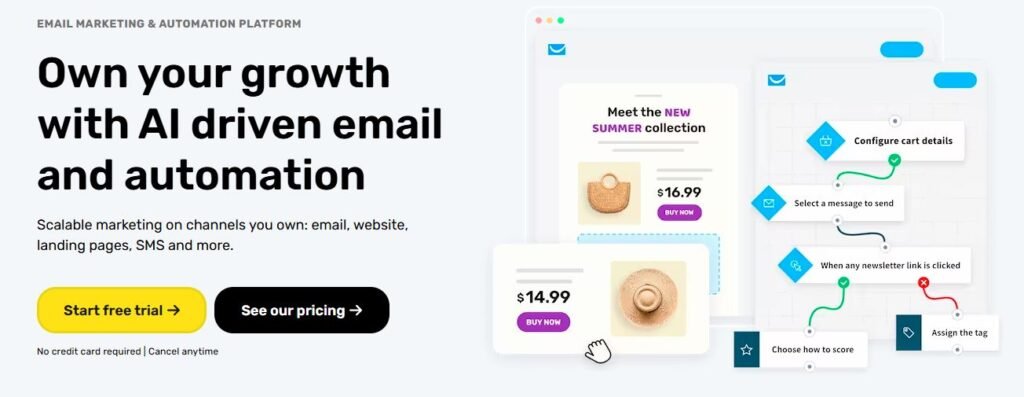
to hep you make a choise, this table shows what GetResponse offers, compare to two other affordable email marketing tools
| Feature | GetResponse | AWeber | Moosend |
|---|---|---|---|
| Core email campaigns (editor, templates, design tools) | Drag‑&‑drop editor; many modern, responsive templates; dynamic content blocks; built-in spam checking & preview tools | Drag‑&‑drop; large template library; mobile-responsive; includes AMP email support and Canva integration | Drag‑&‑drop editor; many templates; landing page templates; mobile responsive; good flexibility |
| Automation & workflows | Strong automation: visual builders; triggers based on behavior; multi-step workflows; scoring, branching logic | More basic automation: autoresponders, tagging, drip sequences; less complex behavior-based branching | Good automation workflows; triggers; segmentation; relatively advanced for its price |
| Landing pages / Capture tools | Yes: landing pages, popups/forms, website builder, conversion funnels | Yes: landing page builder; forms/popups; more limited | Yes: landing page builder; templates; forms; responsive; no-code tools |
| Webinar / Course features | Built-in webinar hosting and course-creation tools | No native webinar/course tools; requires third-party integrations | No built-in webinar tools; focused on email, forms, automation |
| Segmentation, list management & tagging | Advanced segmentation; behavioral/engagement-based filters; tagging; dynamic segments | Good tagging & segmentation; fewer advanced/behavioral options | Strong segmentation and personalization; flexible conditions |
| Analytics / Reporting | Robust analytics: real-time, eCommerce tracking, conversion funnels, performance reports | Solid reporting: opens, clicks, list growth; somewhat simpler | Good reports; real-time analytics; landing page conversion tracking; bounce/unsubscribe monitoring |
| Price / Free-trial / Entry-level cost | Free plan/trial available; paid tiers unlock more features; good value as list grows | Free plan for small lists; pricing increases with contacts; more expensive as you scale | Affordable entry pricing; free trial; good value for core features |
| Ease of use / Learning curve | Moderate-high: many features; steeper learning curve for advanced tools | Easier to pick up; beginner-friendly UI | Clean UI and good onboarding; easier for beginners |
| Deliverability / Authentication / Compliance | Supports SPF/DKIM, domain authentication; good reputation; list hygiene | Strong deliverability; established reputation; supports basics | Offers email authentication; bounce management; GDPR compliance |
| Integrations (3rd-party tools, eCommerce, etc.) | Many integrations (eCommerce, CMS, ads, payments); deep ecosystem | Wide integration list; many popular tools supported | Good integrations; especially eCommerce and forms; slightly fewer than large providers |
| Unique / standout features | Webinars & courses built-in; conversion funnels; unlimited sending on many plans; website builder | AMP email interactivity; live chat + phone support; strong beginner usability | AI-writer for landing pages; flexible landing pages; affordable; lots of customization |
GetResponse Price Plan
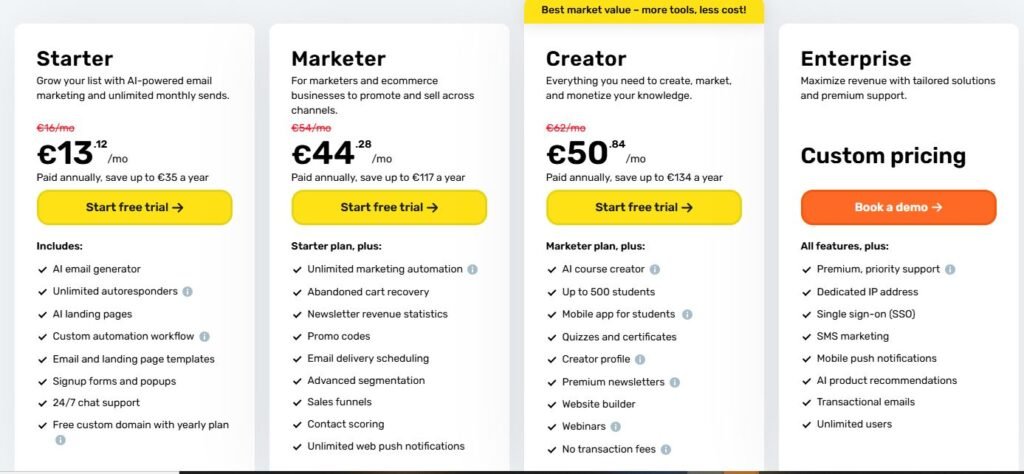
| Plan | Monthly Price (1,000 contacts) | Annual Price (per month) | Biennial Price (per month) | Key Features |
|---|---|---|---|---|
| Free | $0 | N/A | N/A | Up to 500 contacts; 2,500 newsletters/month; basic features; GetResponse branding on emails. |
| Email Marketing | $19 | $15.58 | $13.30 | AI email generator; unlimited autoresponders; custom automation; landing pages; 24/7 chat support. |
| Marketing Automation | $59 | $48.38 | $41.30 | All Email Marketing features plus unlimited marketing automation; abandoned cart recovery; promo codes; advanced segmentation; sales funnels; contact scoring; unlimited web push notifications. |
| Ecommerce Marketing | $119 | $97.58 | $83.30 | All Marketing Automation features plus ecommerce integrations; quick transactional emails; abandoned cart recovery; promo codes; product recommendations; web push notifications. |
| Creator | $69 | $55.68 | $47.90 | All Marketing Automation features plus unlimited courses; webinars (up to 500 attendees); premium newsletters; website builder; mobile app for students; quizzes and certificates. |
| Enterprise | Custom Pricing | Custom Pricing | Custom Pricing | All Creator features plus premium, priority support; dedicated IP address; single sign-on (SSO); SMS marketing; mobile push notifications; AI product recommendations; transactional emails; unlimited users. |
FInal Thought
GetResponse is more than just an email tool, it’s a complete marketing platform that helps you connect with your audience, sell products, and grow your business. It’s packed with features like automation, e-commerce tools, landing pages, and webinars, so you can do a lot from one place. It’s a bit more expensive than basic email tools, but the extra features make it worth it, especially if you want to run professional campaigns without juggling multiple platforms. In short, if you’re serious about growing your business and keeping your subscribers engaged, GetResponse makes it simple and effective.
You want to give it a try?
Click to read GETRESPONSE FULL REVIEW
Visit OUR BLOG PAGE for more
